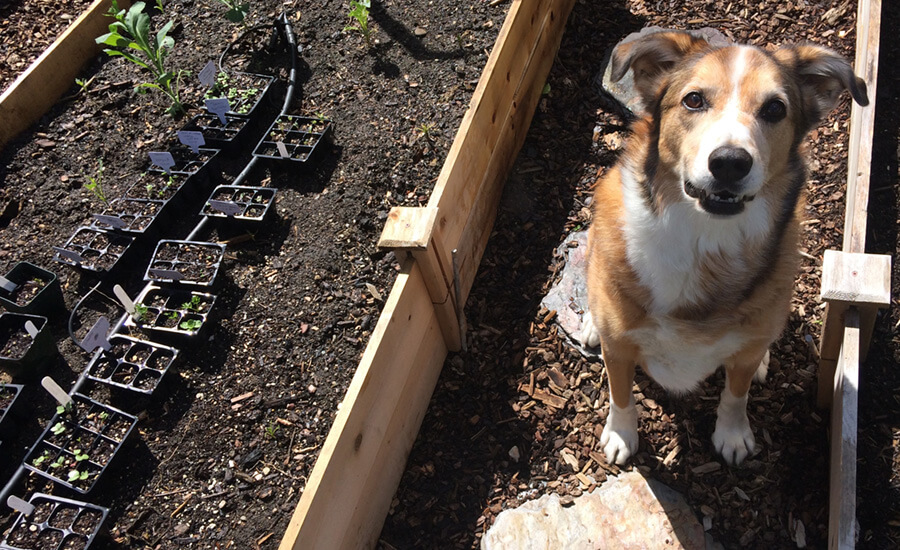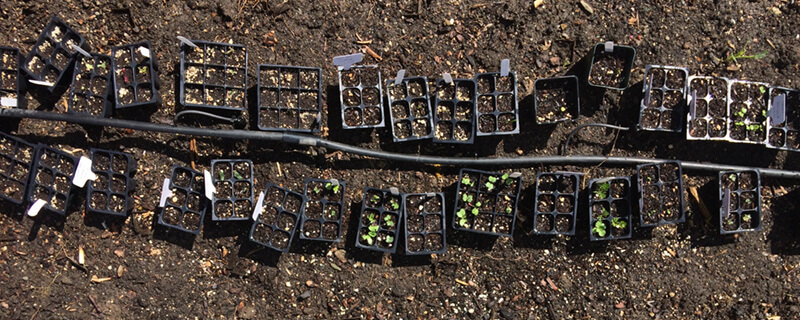
I started volunteering a little over a year ago at an educational farm that grows food for our community’s soup kitchen and food pantries. When I started, the farm was planting its spring crops and gearing up for its annual plant sale fundraiser. So, the first thing I learned in the garden was how to plant seeds. We must have planted thousands of seeds last year, and this year we’re wrapping up an even bigger bounty.
Since our town is also home to a national laboratory, the farm is run by a highly scientific crew (their meticulousness was hard-won in a nuclear lab after all). Their small-scale organic farming methods— from how the soil is prepared, to what is planted, to how seeds are sown, to how plants are managed— are optimized for sustainability, nutrition and high yields.
You may think there’s not much to planting seeds, and at one time I would have agreed with you. But now I know better.
Here are four lessons I’ve learned about planting seeds that can be applied to other creative endeavors.

this is far too many seedlings for our little backyard garden.
1) Read the seed packet
Seed packets include fine-print instructions that cover when and how deep to plant, when to transplant, how far seedlings should be spaced, etc. In creative endeavors, reading the seed packet is the research phase. This is when we get our heads around the Who? What? Where? When? Why? How? of what we’re doing so we’re prepared before we jump in. Answering these questions is as important as, say, making sure you have enough garden space for all the seeds you plant (oops). At the same time, it’s good not get stuck in this phase too long. At some point it’s probably better to simply scatter seeds over bare dirt than it is to never plant them at all. (But don’t tell the scientific gardeners I told you that.)
2) Rinse out the salts
Apparently, store-bought bags of potting soil contain salts that can be harmful to sensitive seedlings. So, before planting seeds, the scientific gardeners water the soil in the seed trays for a few seconds until the water runs out the bottom, thereby rinsing out some of the salts. In creative work, this ‘rinsing’ encompasses the regular practices we apply to help keep ourselves out of or own way. Creating, like living in general, can bring up all kinds of desires and needs and ambiguities and anxieties and associated resistances. But we tend to do our best creative work (and our best living) when we’re, if not free, at least aware of our salty thinking. So… meditate, exercise, journal, get therapy, spend time in nature, pray, hang out with your dog… do what you can to rinse those salts away.
3) Act as if it matters
The scientific gardeners take their seed planting seriously. They carefully prepare soil in the seedling trays, gently tap a few seeds out of a packet into the palm of their hand, press appropriately sized holes into the soil with the eraser-end of a pencil, carefully select seeds with the wet sharpened tip of the pencil, place each seed in each hole, and then pinch each hole closed. One volunteer even likes to talk to each seed as she plants it. This kind of honoring of the process works: mistakes are avoided, the yield is higher, the work is enjoyed. In all creative endeavors, it can be tempting to be indifferent and apathetic. We may doubt the meaning of what we’re doing, and (for creative folk especially) depression and despair may hover near. But we need to act like it matters anyway. This action alone is often enough to provide us with the inspiration and motivation to create. And it may very well be the act of creating that uncovers the meaning.
4) Pay attention
The scientific gardeners keep their seedling trays in temperature-regulated greenhouses with soil sensors and automatic sprinklers. They monitor the progress of each seedling, tend to the small plants as they grow, and re-seed as needed. The productivity of each seed type is tracked year-to-year so that the gardeners know how well seeds do and can adjust what they plant next. We need to be like this too— we need to pay attention to our creative goals and plans, monitor our progress, develop our skills and habits, manage our anxieties and doubts, let go of our disappointments, and try new things. Most of all (at the risk of sounding corny ????), we need to nurture and support our creative dreams, which– like the seeds in the garden–reveal their mystery and beauty when they take sprout.

xo,
Sarah

14 Responses
So many thoughts sprouted (pun intended) from your note for me!
1) I think I’d really like your scientist gardeners. Gotta love their thoroughness and processes!
2) This is a great note on lessons we can learn from a methodical process that’s similar to our creative process.
3) Would love to hear the learnings from tracking YOY data.
4) Nice use of an emoji. 🙂
5) Didn’t know that thing about salt in the potting soil…must try!
6) I love that you bring gardening into your work. I would definitely label you as a “creative cultivator.” You know how and when to let things grow with space + time, and when creative ideas need pruning or guidance to take shape.
Thanks Rosie for reading and your notes. I love the ‘creative cultivator’ title, but I think I’ll give that one to you! Hope all is well!
So, I take it I can beg some seedlings from you;-) Beautiful metaphors, inspiring post as always, Sarah.
Yes! I’m growing extras for you. Thank you Yoli for taking a look and leaving a comment. xo
Thanks for this Sarah. I appreciate it. I think it’s right that the act of creating uncovers the meaning, or at least it’s the approach I like to take with my work. The way I understand this is that I try to let the work have its way, not to be too certain about what it is to be: it is like carefully and thoughtfully tending a seedling, but not knowing what plant it will grow into.
That’s lovely, thanks Tyrell! Your work, which is careful and mysterious, is so inspiring to me.
Look at all those seedlings!! ???? good work!
Thank you Lexa! That’s high praise coming from the lady who can get arugula to in grow in the desert! xo
Thanks Sarah! You always inspire me???? I didn’t know about the salts either…a great little nugget.
Thanks so much Jodi for reading and your sweet comment! Hope all is well in the Pacific Northwest!
Hi Sarah on a rainy day (yahoo) in the east bay. I am jealous of your volunteer gig. Sounds like a great organization. I think #4 is perfect for me at the moment. Pay attention. Keep on inspiring us.
Hi Chris! Thank you for taking a look and writing a note. Good to hear from you as always. I still need to come visit your new EB digs. (We can check out your local yarn shop!)
Dearest Ms. Green Jeans,
This is just the most lovely, timely, uplifting piece of writing I’ve read in a long time. I’m so happy I saved it for the perfect moment to enjoy the fruits of your labor. It’s a keeper!
Thank you so much Naomi! You’re the best. I’m so looking forward to reading all of your writing this spring! (And toasting our efforts with umbrellas in our drinks!)